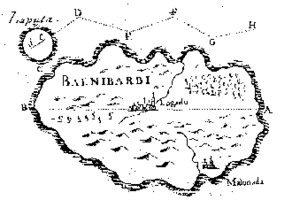Laputa
| Laputa | |
|---|---|
| Gulliver's Travels location | |
 Map of Laputa and Balnibarbi (original map, Pt III, Gulliver's Travels) | |
| Created by | Jonathan Swift |
| Genre | Satire |
| In-universe information | |
| Type | Flying island |
| Characters | King |


Laputa /ləˈpuːtə/ is a flying island described in the 1726 book Gulliver's Travels by Jonathan Swift.[1] It is about 4+1⁄2 miles (7 kilometres) in diameter, with an adamantine base, which its inhabitants can manoeuvre in any direction using magnetic levitation. The island is the home of the king of Balnibarbi and his court, and is used by the king to enforce his rule over the lands below.
Location
Laputa was located above the realm of Balnibarbi, which was ruled by its king from the flying island. Gulliver states the island flew by the "magnetic virtue" of certain minerals in the grounds of Balnibarbi which did not extend to more than 4 miles (6.5 kilometres) above, and six leagues (29 kilometres) beyond the extent of the kingdom,[2] showing the limit of its range. The position of the island, and the realm below, is some five days' journey south-south-east of Gulliver's last known position, 46° N, 183° E[3] (i.e. east of Japan, south of the Aleutian Islands)[4] down a chain of small rocky islands.[3]
Legacy
On Mars's largest moon, Phobos, there is a feature named regio, Laputa Regio, which is named after Swift's Laputa because of his 'prediction' of the two then undiscovered Martian moons, which his Laputan astronomers had discovered.[5]
The 1986 Japanese animated fantasy film, Castle in the Sky, directed by Hayao Miyazaki, derives its name and basic premise from Swift's novel.[6]
References
Citations
- ^ Williams 1968.
- ^ Swift 2008, p. 157.
- ^ a b Swift 2008, p. 143.
- ^ Swift 2008, p. 319.
- ^ USGS.
- ^ Miyazaki 2009, p. 252; Napier 2018, p. 88.
Sources
- Miyazaki, Hayao (2009) [1996]. Starting Point: 1979–1996. Viz Media. ISBN 978-1-4215-6104-2.
- Napier, Susan J. (2018). Miyazakiworld: A Life in Art. Yale University Press. ISBN 978-0-300-22685-0.
- Swift, Jonathan (2008) [1726]. Gulliver's Travels. Oxford World Classics. introduction by Claude Rawson, explanatory notes by Ian Higgins (reprint ed.).[ISBN missing]
- Williams, Kathleen (1968). "Gulliver in Laputa". In Brady, Frank (ed.). Twentieth Century Interpretations of Gulliver's Travels: A Collection of Critical Essays. Prentice-Hall. pp. 60 & ff. ISBN 9780133715675.
- "Laputa Regio". Gazetteer of Planetary Nomenclature. USGS. Retrieved 29 May 2024.
Further reading
- Page, Michael; Ingpen, Robert (1998). Encyclopedia of Things That Never Were. New York: Penguin Studio. pp. 94, 150–1. ISBN 0-14-010008-3.
